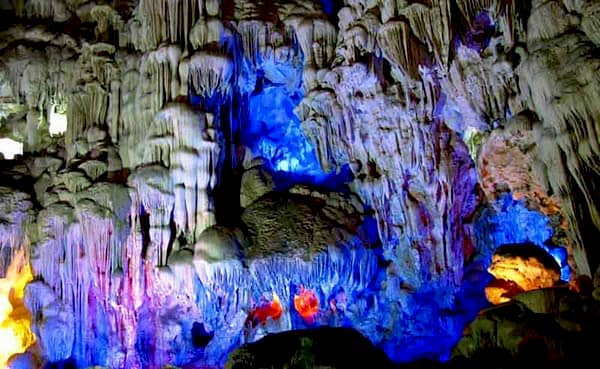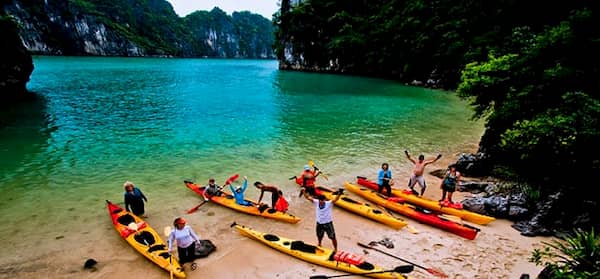HALONG BAY - NORTHERN VIETNAM
A true wonder of nature...
Located
in the Gulf of Tonkin in northern Vietnam, Halong Bay is a natural marine water
bay, elected in 2011 as one of the seven new wonders of nature. It has also
been a UNESCO World Heritage Site since 1994 (with an extension in 2000), and
the list does not stop there since Halong Bay is also part of the most
beautiful bays in the world, making it a truly must-see destination during your
trip to Vietnam.
The bay is located 170 km east of Hanoi, between Halong City and Cat Ba National Park. It includes 1,969 karst islands (some of which can reach a height of 100 m), inland lakes, as well as numerous caves, caves, beaches and coves. All this together makes it possible to define Halong Bay as the largest marine karst in the world. Of all the islands in the bay, 989 are named after their shapes, such as the islet Khi (monkey), the islet Voi (elephant) or the islet Mai Nha (roof).
Halong Bay's climate is tropical, with an average temperature between 15 and 25°C. There are two seasons: a hot and humid summer and a dry and cold winter. There are about 200 species of fish and 450 molluscs. The tropical jungle forest vegetation of the islands is home to wild animals such as antelopes, iguanas, monkeys and many species of birds.
Halong
Bay has a place in world popular culture, notably by having served as a
backdrop for films such as Indochina (with Catherine Deneuve), Tomorrow Never
Dies from the James Bond saga (with Pierce Brosnan) or Kong: Skull Island
released in 2017.
History of Halong Bay
In Vietnamese, this bay is called Vinh Ha Long, which means "descent of the dragon". A local legend has it that it was the Jade Emperor who sent a protective dragon mother and her babies to help the Vietnamese defend themselves against invaders. The dragon family would then have spit jewels and jewellery into the bay, which would then turn into islands and islets to stand in front of the invaders' ships.
Another version of this legend says that the bay was created by a dragon who lived in the mountains near the sea. With his tail, he would have dug deep ruts in the ground between the sea and the mountains. Then they would have been flooded by the sea when the dragon plunged into the water.
In addition to this legend, the caves of Halong Bay have been inhabited since prehistoric times. The bay is located 170 km east of Hanoi, between Halong City and Cat Ba National Park. It includes 1,969 karst islands (some of which can reach a height of 100 m), inland lakes, as well as numerous caves, caves, beaches and coves. All this together makes it possible to define Halong Bay as the largest marine karst in the world. Of all the islands in the bay, 989 are named after their shapes, such as the islet Khi (monkey), the islet Voi (elephant) or the islet Mai Nha (roof).

Wooden cave in Halong Bay
The bay has also been the site of several naval battles. A real labyrinth between all the islets, the Vietnamese army was able to take advantage of this aspect to push back three times the Chinese Empire, a country bordering Vietnam. In the "Bouts de Bois Cave", piles that had been used in the past were found and then exhibited at the Haiphong City Museum.
At
the end of the 18th century, piracy was present in the bay and the Vietnamese
and Chinese authorities were unable to eradicate it. It was the Royal Navy (of
the British Empire) that drove them from the site from 1810 onwards.
Then, from 1887 to 1954, dates corresponding to the colonization of French Indochina, French settlers exploited the coal deposits on site and named several islets after mapping the bay.
Finally,
Halong Bay also experienced the Vietnam War. The United States had also mined a
large number of passages in the bay.
What to do in Halong?
Beaches
and kayaks
The incredible biodiversity, combined with the supernatural landscapes, makes Halong Bay one of the most important and popular destinations in northern Vietnam. By visiting the site, you can admire the nature that surrounds you and enjoy the beaches throughout the bay. Water sports lovers will also appreciate the unique setting for kayaking.

Kayaking in Halong Bay
Fishing
villages
The
bay also includes several fishing villages that attract visitors because of
their authenticity. An example of a village is Cua Van, who was elected as one
of the 16 most beautiful villages in the world by Journeyetc.com in 2012.
Overnight
on board a junk
Finally,
it is possible to spend one or more nights in Halong Bay on a junk. There are
different types of them that navigate the site. This allows you to enjoy tasty
meals and magnificent sunsets, while admiring incredible scenes such as the mix
of cargo boats, tourists, typical boats and fishing villages. An unforgettable
night in perspective during your trip to Northern Vietnam.
Some tips during your stay in Ha Long
- Don't miss the Sung Sot Cave (known as the Surprise Cave), which is one of the most beautiful caves on the site despite the large number of tourists.
- Don't hesitate to get up early for a chance to admire an exceptional sunrise.
-
If you have time, stop at the Tung Sau Pearl Farm. You can learn more about the
bead making process and bring back great memories.



